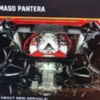...Or was it 16 MPG?? Don't remember.
Doug, Agreed! Dual Planes have 4 + 4 unequal Runners. How are these (Above) for all 8 Equal? The Length is Exactly at 7.0", center of Port at Plane to Top of Plate. Yes, 4.5" Would be Optimum.
I still have to De-Burr and Polish the Inside Radii.
Yes! Have a Great Fathers' Day!!
Marlin
The C60A dual 4 intake has 8 equal length runners! In addition, it is a180° design!
Exactly how this was done? I don't know, but even you will be speechless when you see it and have one in your hands! It is an amazing design.
I do know that Ford had several sources for designing and building intakes. I couldn't tell you who did the original design on the C60A but I was hoping that I could find a continuation of the train of thought manifold into the 351c engine series. So far I have not.
One of the things encouraging me on the quest is that the thought in fact WAS continued into the 429 engine series and that manifold does exist.
One key factor is that you need to consider is it was made for an 8.0" deck height block. That creates opportunities for the runner length being optimum.
From what I have learned/seen, so far with the induction possibilities, I am leaning to a 2 x 4 Holley 180° intake with equal runner lengths as the optimum induction on a STREET DRIVEN Pantera. This has largely to do with the ability of progressive throttle linkage to control the beast or keep it docile.
You can run around all day on the primaries of one 1850 Holley and yet use it as a 600cfm "double pumper" with vacuum controlled secondaries as "rocket afterburners" on a Cleveland that has the port flow to use it.
Unfortunately for the Cleveland, if that manifold was being worked on at the time of Ford's racing program cancellation, it has never seen the light of day but I suspect it would have been the ultimate, significantly even over individual runner intakes because of the progressive linkage thing.
Once you see the intake Marlin. It will answer all of your questions. Many if most have no idea that it ever existed.
I love what you have done with the Wieand Tunnel ram. It is exactly along the lines of what I am talking about.
Realize that at the time of the C60A design, the "tunnel ram" intakes didn't exist.
What "Ford" did though was to tie the two carb plenums together, so that there was a bridge between them. In that way it made it possible to run/idle on just one. So it would be accurate to describe the C60A as a hybrid manifold of a low 2x4 tunnel ram, which it would run at as a WOT intake, and yet have the idle characteristics of "street driven" single 4v 180° intake. Certainly for the time a very abstract thought and yet one that has even current "carburetor-ed" applications.
I saw your intake project before and was always waiting for you to come to this conclusion of attaching the two plenums together in order to idle on only one carb. The question to me was what would be the size of that tunnel connection?
I would guess and say it is the size used on this C60A?
To me, this is a very interesting and significant discussion. One thing that you can't easily deal with on that Wieand is the total height of the manifold. Anything that you do is going to be very tall. The C60A is only 4.5" tall at the carb base so it fits under the hood of a stock Mustang. It's really a very stealth type of thought process the entire way.
The runners on it will show a flow of around 250cfm unported. So I don't know even if you had one if you would want to make it fit on a Cleveland with adapters? On my 347 with AFR heads it works fine. Maybe, extrude hone the thing so you don't ruin it?
I agree with Marlin on the tall single 4v "spider" type intakes. They are all essentially "tunnel rams" and will likely dyno out all very similarly to each other. The biggest point with that is they are high rpm manifolds for the most part and are all going to a be a bit flat off of idle? I wouldn't expect there to be more then a 10 or 15hp difference between them.
In a dyno comparitive test, I'd be curious to see how well the Edelbrock "Scorpion" does against them. The Torker itself is quite a torky and responsive manifold. The Scorpion is the race version of the Torker.
Having "been there and done that" I need someone to explain to me how a 5,000-10,000 rpm intake is the way to go on a street Pantera? I don't see it at all.
























